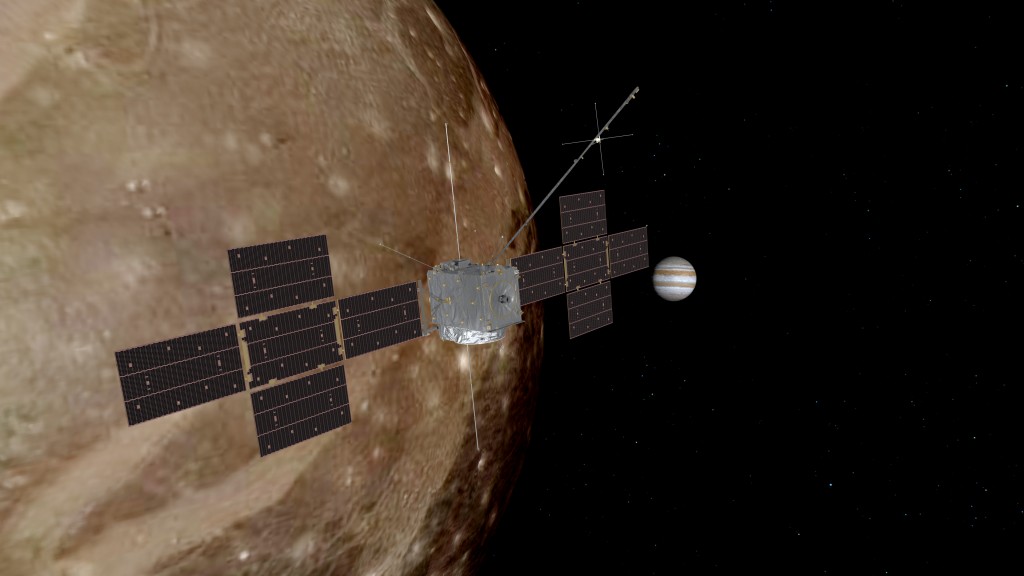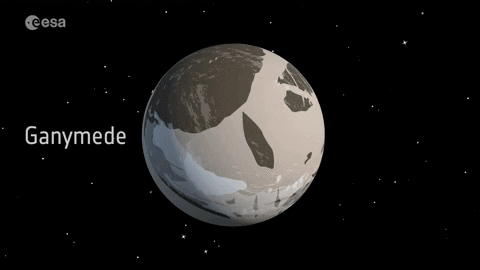JUICE: Exploring the Icy Moons of Jupiter
On 13 April 2023 at 14:15 Belgian time, the ESA spacecraft JUICE will take off on board an Ariane 5 launcher from ESA’s Spaceport in Kourou, French Guyana. After an 8-year-long journey, JUICE, an acronym for JUpiter ICy moons Explorer, will investigate Jupiter and its icy moons, with a special focus on Ganymede, the largest moon in the solar system. In December 2034, the spacecraft will be inserted in orbit around Ganymede. It will be the first time a spacecraft will orbit a moon other than our own. The Royal Observatory of Belgium (ORB-KSB) and the Royal Belgian Institute for Space Aeronomy (BIRA-IASB) are involved in this mission.
JUICE aims to answer fundamental questions about Jupiter and its moons. One such question is whether icy moons could have the right conditions for the emergence of life. Europa, Ganymede, and Callisto, the three large icy moons of Jupiter, may harbour a liquid water ocean beneath their ice shell. Liquid water is one of the necessary conditions for developing and sustaining life, in addition to biologically essential elements and energy. By investigating the interior of the icy moons, JUICE will determine whether these conditions are fulfilled in those moons.

Artist’s impression of the spacecraft JUICE orbiting Ganymede, with Jupiter in the background. Credits: ESA/ATG Medialab.
Implication of the Royal Observatory of Belgium
The Royal Observatory of Belgium is involved in four of the ten JUICE instruments. Tim Van Hoolst, planetologist at the ORB-KSB, is a Co-Investigator (Co-I) of the radio science package 3GM (Gravity and Geophysics of Jupiter and the Galilean Moons) and of the Jovian MAGnetometer J-MAG. He explains that ‘both instruments will be used to probe the interior of the moons. The magnetometer will observe the induced magnetic field generated in the subsurface ocean, and radio science will measure the gravity field, rotation and tides of the moons.’
‘Tidal deformations of Ganymede, which lead to weekly upward and downward motions of the ice surface by a few metres, will also be measured by the GAnymede Laser Altimeter (GALA)’, says Marie Yseboodt, Co-I of the instrument. GALA will also determine an accurate topography map of Ganymede.
Scientists will analyse data from the MAJIS instrument (Moons And Jupiter Imaging Spectrometer) to characterise the ices and minerals on the surfaces of icy moons and their connection with the subsurface. Özgür Karatekin, instrument Co-I, is proud of the highly collaborative aspect of the development of the instrument: ‘Dozens of engineers, technicians and scientists from public institutes and private partners in France, Italy, Belgium and the United States participated in the realisation of this instrument. In particular, the ORB-KSB with our colleagues at the BIRA-IASB contributed to the characterisation of the instrument’s detectors.’

Animation of the interior’s structure of Jupiter’s moon Ganymede. Credit: ESA/ATG Medialab.
Tim Van Hoolst, also leader of the JUICE Working Group on Internal structure, subsurface and geophysics of giant icy moons, explains: ‘The instruments will work in synergy to accurately characterise the interior of the icy moons, answering questions that have remained unanswered since the end of the Galileo mission. Do the three icy moons have a subsurface ocean? How thick are the ice shell and the liquid ocean? What is their composition? Why does Ganymede generate a magnetic field?’
Implication of the Royal Belgian Institute for Space Aeronomy
Once an instrument is as far away from Earth as Jupiter can be, it is difficult to make sure it performs as was intended by its makers, especially in the harsh conditions of space with extremely low temperatures and near-vacuum. Moreover, some measurements used to characterise the response of the instrument are not feasible in space. Therefore, characterising the response of an instrument’s components in a strictly controlled laboratory environment is a crucial part of the development phase.
David Bolsée and his team in the B.RCLab (Belgian Radiometric Characterisation Laboratory) of the Royal Belgian Institute for Space Aeronomy developed and validated the characterisation bench (configuration of the laboratory equipment). This facility has been designed for performing the full radiometric and electro-optic characterisation in cryogenic conditions of both the flight and spare models of the MAJIS VIS-NIR detector (VISible and InfraRed light), under the supervision of the French ‘Institut d’Astrophysique Spatiale’, with the support from BELSPO and ESA. These campaigns took place in 2020 and 2021.
A Long Journey to Jupiter
Once launched, JUICE will set off on a long journey to Jupiter, adjusting the course of its trajectory a number of times through fuel-saving manoeuvres known as gravity assists. After its orbital insertion around Jupiter in July 2031, JUICE will perform thirty-five flybys of the moons Europa, Ganymede and Callisto. In the final phase of its journey, JUICE will orbit around Ganymede in 2034 and 2035.
Scientists of ORB-KSB and BIRA-IASB are looking forward to the data of the JUICE mission and to the new insights that it will make possible!
More information:
ESA JUICE launch kit (with links to infographics, images and videos):https://esamultimedia.esa.int/docs/science/Juice-LaunchKit.pdf.
Contact communication:
Lê Binh San Pham
lebinhsan.pham@oma.be
Tel. : +32 2 373 03 03

